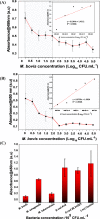Peroxidase-Mimicking Activity of Biogenic Gold Nanoparticles Produced from Prunus nepalensis Fruit Extract: Characterizations and Application for the Detection of Mycobacterium bovis
- PMID: 35545815
- PMCID: PMC9214696
- DOI: 10.1021/acsabm.2c00180
Peroxidase-Mimicking Activity of Biogenic Gold Nanoparticles Produced from Prunus nepalensis Fruit Extract: Characterizations and Application for the Detection of Mycobacterium bovis
Abstract
In the present study, a facile, eco-friendly, and controlled synthesis of gold nanoparticles (Au NPs) using Prunus nepalensis fruit extract is reported. The biogenically synthesized Au NPs possess ultra-active intrinsic peroxidase-like activity for the oxidation of 3,3',5,5'-tetramethylbenzidine (TMB) in the presence of H2O2. Chemical analysis of the fruit extract demonstrated the presence of various bioactive molecules such as amino acids (l-alanine and aspartic acids), organic acids (benzoic acid and citric acid), sugars (arabinose and glucose), phenolic acid, and bioflavonoids (niacin and myo-inositol), which likely attributed to the formation of stable biogenic Au NPs with excellent peroxidase-mimicking activity. In comparison with the natural horseradish peroxidase (HRP) enzyme, the biogenic Au NPs displayed a 9.64 times higher activity with regard to the reaction velocity at 6% (v/v) H2O2, presenting a higher affinity toward the TMB substrate. The Michaelis-Menten constant (KM) values for the biogenic Au NPs and HRP were found to be 6.9 × 10-2 and 7.9 × 10-2 mM, respectively, at the same concentration of 100 pM. To investigate its applicability for biosensing, a monoclonal antibody specific for Mycobacterium bovis (QUBMA-Bov) was directly conjugated to the surface of the biogenic Au NPs. The obtained results indicate that the biogenic Au NPs-QUBMA-Bov conjugates are capable of detecting M. bovis based on a colorimetric immunosensing method within a lower range of 100 to 102 cfu mL-1 with limits of detection of ∼53 and ∼71 cfu mL-1 in an artificial buffer solution and in a soft cheese spiked sample, respectively. This strategy demonstrates decent specificity in comparison with those of other bacterial and mycobacterial species. Considering these findings together, this study indicates the potential for the development of a cost-effective biosensing platform with high sensitivity and specificity for the detection of M. bovis using antibody-conjugated Au nanozymes.
Keywords: Mycobacterium bovis; biogenic nanoparticles; biosensing; green synthesis; indirect enzyme-linked immunosorbent assay (iELISA); peroxidase-mimicking.
Conflict of interest statement
The authors declare no competing financial interest.
Figures








Similar articles
-
Enhanced colorimetric detection of norovirus using in-situ growth of Ag shell on Au NPs.Biosens Bioelectron. 2019 Feb 1;126:425-432. doi: 10.1016/j.bios.2018.10.067. Epub 2018 Nov 1. Biosens Bioelectron. 2019. PMID: 30471568
-
Catalytic ferromagnetic gold nanoparticle immunoassay for the detection and differentiation of Mycobacterium tuberculosis and Mycobacterium bovis.Anal Chim Acta. 2021 Nov 1;1184:339037. doi: 10.1016/j.aca.2021.339037. Epub 2021 Sep 13. Anal Chim Acta. 2021. PMID: 34625241
-
Enhanced glucose detection using dendrimer encapsulated gold nanoparticles benefiting from their zwitterionic surface.J Biomater Sci Polym Ed. 2018 Dec;29(18):2267-2280. doi: 10.1080/09205063.2018.1541499. Epub 2018 Nov 24. J Biomater Sci Polym Ed. 2018. PMID: 30382000
-
Nanomagnet-Silica Nanoparticles Decorated with Au@Pd for Enhanced Peroxidase-Like Activity and Colorimetric Glucose Sensing.ACS Appl Mater Interfaces. 2020 Jan 15;12(2):1973-1987. doi: 10.1021/acsami.9b15123. Epub 2020 Jan 3. ACS Appl Mater Interfaces. 2020. PMID: 31846292
-
Three-dimensional MoS2 nanoflowers supported Prussian blue and Au nanoparticles: A peroxidase-mimicking catalyst for the colorimetric detection of hydrogen peroxide and glucose.Spectrochim Acta A Mol Biomol Spectrosc. 2021 Oct 5;259:119886. doi: 10.1016/j.saa.2021.119886. Epub 2021 Apr 30. Spectrochim Acta A Mol Biomol Spectrosc. 2021. PMID: 33991816
Cited by
-
Biogenic metallic nanoparticles as enzyme mimicking agents.Front Chem. 2023 Mar 7;11:1107619. doi: 10.3389/fchem.2023.1107619. eCollection 2023. Front Chem. 2023. PMID: 36959878 Free PMC article. Review.
-
Peroxidase-Mimicking Nanozymes of Nitrogen Heteroatom-Containing Graphene Oxide for Biomedical Applications.Biosensors (Basel). 2025 Jul 7;15(7):435. doi: 10.3390/bios15070435. Biosensors (Basel). 2025. PMID: 40710085 Free PMC article. Review.
-
Colorimetric Detection of Dopamine Based on Peroxidase-like Activity of β-CD Functionalized AuNPs.Molecules. 2025 Jan 20;30(2):423. doi: 10.3390/molecules30020423. Molecules. 2025. PMID: 39860291 Free PMC article.
-
Staining-Enhanced Peroxidase-Mimicking Gold Nanoparticles in Nano-ELISA for Highly Sensitive Detection of Klebsiella pneumoniae.ACS Omega. 2023 Dec 13;8(51):49211-49217. doi: 10.1021/acsomega.3c07503. eCollection 2023 Dec 26. ACS Omega. 2023. PMID: 38162724 Free PMC article.
-
Copper nanocubes as low-cost enzyme mimics in a sarcosine-sensing reaction cascade.Analyst. 2025 Mar 24;150(7):1248-1260. doi: 10.1039/d4an01242a. Analyst. 2025. PMID: 40019350 Free PMC article.
References
-
- Slocik J. M.; Naik R. R.; Stone M. O.; Wright D. W. Viral Templates for Gold Nanoparticle Synthesis. J. Mater. Chem. 2005, 15, 749–753. 10.1039/b413074j. - DOI
-
- Yang N.; Weihong L.; Hao L. Biosynthesis of Au Nanoparticles Using Agricultural Waste Mango Peel Extract and Its in Vitro Cytotoxic Effect on Two Normal Cells. Mater. Lett. 2014, 134, 67–70. 10.1016/j.matlet.2014.07.025. - DOI
-
- Raghunandan D.; Basavaraja S.; Mahesh B.; Balaji S.; Manjunath S. Y.; Venkataraman A. Biosynthesis of Stable Polyshaped Gold Nanoparticles from Microwave-Exposed Aqueous Extracellular Anti-Malignant Guava (Psidium Guajava) Leaf Extract. Nanobiotechnology 2009, 5, 34–41. 10.1007/s12030-009-9030-8. - DOI
Publication types
MeSH terms
Substances
LinkOut - more resources
Full Text Sources
Other Literature Sources

